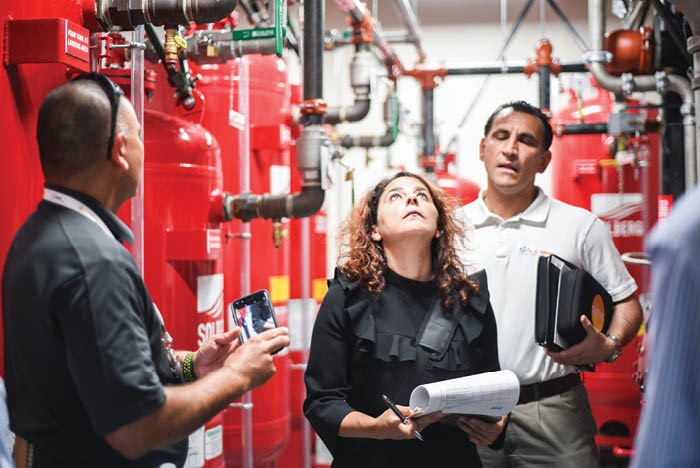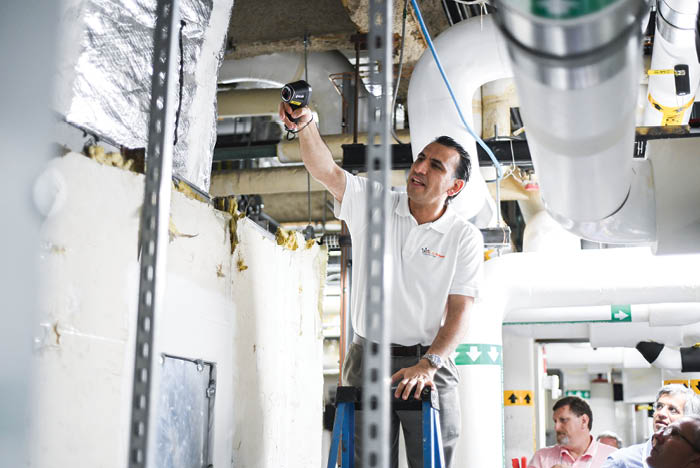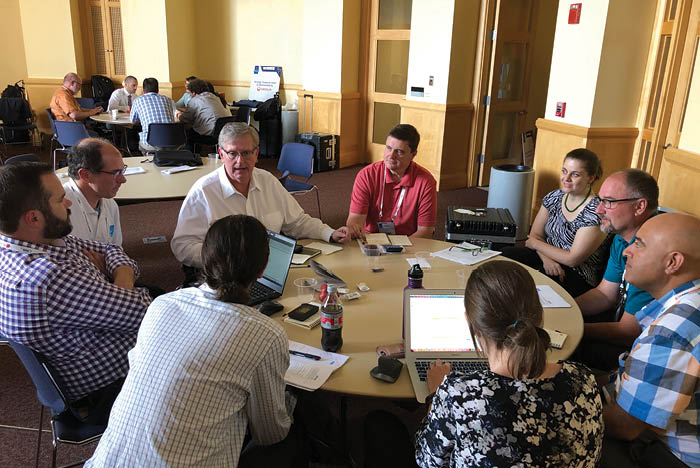Energy Treasure Hunt reveals hidden inefficiencies

Surveying the mechanical rooms are (from left) Ravi Babra, project director at Kitchell; and Milly Ruiz, office manager, and Mohamad Jamal, president, at A.J. Adam Engineering LLC.
Photo courtesy of ASHE
Editor's note: The 2023 International Summit & Exhibition for Health Facility Planning, Design & Construction is hosting an Energy to Care Treasure Hunt as a post-conference event March 15-16. The event, sponsored by Johnson Controls, is being offered at a reduced cost of $150 — a $350 savings for participants.
The following article was published in Health Facilities Management's May 2020 issue, and provides a sneak peek into what Energy to Care Treasure Hunt(ers) can look forward to at this year's event.
When Richie Stever, CHFM, CLSS-HC, director of operations and maintenance at the University of Maryland Medical Center (UMMC) in Baltimore, set out to bring an Energy to Care Treasure Hunt to his organization, his goal was simple. He wanted to find opportunities to save energy that would help UMMC reach its target of decreasing energy consumption by 20% by 2022.
But what came out of the two-day event in July 2019 was substantial: a comprehensive list of no-cost and low-cost measures that could yield over $2 million of energy savings.
Part of the Energy to Care program of the American Society for Health Care Engineering (ASHE), treasure hunts bring together teams of professionals to identify, evaluate and assess energy savings potential in health care facilities. The ASHE treasure hunts emerged from earlier energy treasure hunts organized through the ENERGY STAR® commercial buildings program at the Environmental Protection Agency.
In addition to the UMMC treasure hunt, ASHE has facilitated events at the Conway Regional Medical Center in Conway, Ark.; Northwest Hospital & Medical Center in Seattle; Phoenix Children’s Hospital in Phoenix; and CHA Cambridge Hospital in Cambridge, Mass.
The UMMC event took place in conjunction with the 2019 ASHE Annual Conference & Technical Exhibition in Baltimore.
Making preparations
The broader goal of the treasure hunts is to give participants the skills, knowledge and tools to take on energy savings initiatives in their own organizations, says Kara Brooks, LEED AP BD+C, sustainability program manager at ASHE.
“A lot of times when you talk about sustainability, people are thinking of things like green roofs and recycling, and they don’t think of simple things like turning off a monitor or turning off the lights in a conference room and how much that’s costing,” Brooks says. “Our goal is to train people to see those things and then take that back to their own facilities or departments and teach other people to be aware.”
According to Brooks, a treasure hunt takes about six to eight weeks to organize. For the UMMC treasure hunt, the ASHE team gathered and analyzed detailed data and information about the facility’s energy use performance, infrastructure, equipment and building systems.
“When the participants come in, we have all that information ready to go and plugged into our calculators,” says Lindsey Brackett, president and co-founder of Legacy FM LLC and ASHE faculty for Energy to Care educational programs. “Then we’re not spending time trying to compile and aggregate that information on-site.”
Medical facilities are also extremely complex environments, with a great deal of energy-intensive equipment compared to commercial office buildings and educational facilities, says Brackett.
Additionally, elements such as air pressurization, outside air requirements, and simultaneous heating and cooling systems can mean more opportunities for energy savings but also can make pinpointing potential improvements challenging. Therefore, ensuring that participants are ready to hit the ground running at treasure hunts is essential.
Brackett, who was lead facilitator of the UMMC treasure hunt, prepared participants prior to the event through a series of webinars so that they required minimal training when they arrived at the UMMC site. This preparation also ensured that teams could focus as much time as possible on identifying and analyzing potential energy savings opportunities.
ASHE facilitators organized the event teams from a diverse pool of participants that included facilities managers, sales representatives, suppliers, manufacturers, and staff from federal agencies and advocacy organizations. The teams were also made up of people from many different industries and types of facilities, and this mix of expertise and perspectives helped them identify a broad range of energy savings measures.
Discovering savings

Babra records the electrical details of a variable-frequency drive for a chilled water pump.
Photo by Richie Stever
The UMMC treasure hunt kicked off with an orientation that reviewed how teams should identify issues in the field and gather data. Participants also learned to use the energy audit equipment — including light meters, temperature sensors and thermal imaging cameras — that ASHE made available.
Five teams then set out to search for energy savings opportunities throughout the massive 2.5-million-square-foot UMMC facility. The teams focused on different areas of the facility: two teams covered mechanical spaces, two teams looked at patient care spaces and one team assessed the facility’s public spaces.
As they combed every part of the facility, the teams took on-site measurements that they could then use to determine potential energy savings. For example, Stever’s team looked closely at the mechanical rooms, central plant and roof areas and found that louvers were leaking from the building to the outside. Team members measured the amount of air leakage and used those figures to calculate what this one issue was costing UMMC.
Together the teams identified a host of preventive maintenance actions, repairs and adjustments, and behavioral changes that could be implemented across the facility. The opportunity for energy savings by reducing operating room air changes, cleaning air filters, insulating pipes in mechanical rooms, and turning off lights in offices and restrooms when not in use were just a handful of the UMMC treasure hunt findings.
The teams regrouped to review what they had discovered in the field and to prioritize initiatives, particularly those that would require capital funding. Stever’s team evaluated the energy savings opportunities based on the return on investment and the time needed for implementation. “If something was going to take a long time and a lot of money, we didn’t prioritize that as much,” Stever says.
At the conclusion of the event, the teams gave final presentations to their treasure hunt colleagues and to UMMC facility staff and senior leadership. They highlighted the top energy savings opportunities as well as the financial benefits of millions of dollars saved and the environmental ones, including significant electricity, steam and water reductions.
The teams found a slew of no-cost opportunities, with potential annual savings totaling more than half a million dollars, including repairing air leaks on air compressors ($5,000), raising temperatures in mechanical and electrical rooms ($257,300), putting computers and monitors in sleep mode when not in use ($120,000), adjusting the building temperature for the seasons ($104,000), removing mini refrigerators from office spaces ($11,942), adjusting air terminal unit settings ($913) and repairing leaking faucets ($13,170).
Implementing change

Mohamad Jamal takes temperature readings of mechanical equipment.
Photo courtesty ASHE
For projects that would require capital funds, Stever worked with UMMC’s chief financial offer to further refine the list of priority projects: repair Weinberg humidifier steam leaks ($154,000), conduct steam trap audit and repairs ($100,000), repair leakage of atrium dampers ($145,000), remove storage room lights ($87,430), install additional LED lights ($245,000) and reset chilled water temperature ($300,000).
Stever was subsequently invited to present to UMMC’s capital planning committee, which approved $400,000 of funding to cover the humidifier, steam trap, atrium damper and storage room lights projects. He says he appreciates that the committee understood the treasure hunt as a valuable use of UMMC’s staff time and resources and that it also devoted funds to ensure these energy savings projects would move forward (see sidebar on page 23).
The key to connecting effectively with UMMC’s leadership, Stever says, was conveying the potential cost savings in clear and tangible finance terms, specifically patient revenue and patient days. For example, the $154,000 of annual savings that would result from addressing the humidifier steam leaks translated to $14,221,900 of equivalent patient revenue and 2.73 patient days.
Additional benefits

Tim Staley (left), ASHE Energy to Care education faculty member, and Kumars Haidari, mechanical engineer at the National Institutes of Health, look at static pressure readings on an air handling unit.
Photo courtesty ASHE
Beyond the cost and energy savings that emerge from treasure hunts, the events also foster partnerships between groups with similar sustainability goals and encourage peer relationships within organizations that can continue well into the future.
The UMMC treasure hunt brought together ASHE and the Better Buildings Alliance, an initiative of the Department of Energy, in a collaborative process with far-reaching impacts.
ASHE provided the support and resources necessary for the treasure hunt, which offered a level of collective expertise that would have been extremely costly to pull together independently through an energy audit. After the event, the Better Buildings Alliance developed an implementation model based on the treasure hunt that it has made widely available to hundreds of partner organizations through its resource and educational platform, the Better Buildings Solution Center.
The energy treasure hunts also are a valuable way for facilities staff to establish relationships with peers within their organizations, such as clinical care providers and administrators, says Clark Reed, national program manager at ENERGY STAR.
“With energy treasure hunts, you’re engaging a lot of people who have never focused on saving energy before or been asked for their recommendations,” Reed says. “These people bring a fresh set of eyes as teams go through a facility and weigh in on what can be done to improve day-to-day operations. And their feedback goes directly to the people who can help improve that energy situation.”
Cara Cook, R.N., AHN-BC, climate and health program manager at the Alliance of Nurses for Healthy Environments, was the only direct care provider who participated in the UMMC energy treasure hunt. She agrees that these events are an extremely useful way for clinical staff, such as nurses, to connect with facilities staff and to provide useful insight into areas of health care facilities that clinicians know well.
“Sometimes it can be very hard to get buy-in from staff members for sustainability initiatives,” Cook says. “They’re already so involved with patient care, and there are many demands put on them. But, through events like the treasure hunt, direct care providers get an understanding of operations and why energy savings is important. And then they take ownership and know they can have an impact through those initiatives.”
While the measurable outcomes of treasure hunts from decreased energy waste are clear, the broader and long-term benefits should not be underestimated. “Perhaps the biggest value of treasure hunts is the institutionalization of energy management across the organization,” Reed says. “It’s no longer considered a problem of facility operations. It’s now something that all aspects of the hospital can be responsible for and do.”
Demonstrating great things

Treasure hunt team members discuss their findings and prepare their presentation to UMMC’s leadership.
Photo by Richie Stever
The UMMC treasure hunt was a valuable undertaking in a variety of ways. Most notably, it unearthed many opportunities to reduce the facility’s energy costs and carbon footprint. The particular challenges of reducing energy use in health care facilities also made the treasure hunt an invaluable experience for participants and resource for their organizations.
“During a treasure hunt, you’re in a team environment, you’re using the tools and you’re getting exposure to other industry experts,” Brackett says. “The focus is on this collaborative effort and projects that can be implemented at little or no cost. The value that you get out of this in two days is immense, and there’s nothing like it in the field.”
For health care facilities managers such as Richie Stever, treasure hunts take their passion for energy savings to the next level by creating measurable, visible change.
“Often, facilities departments are the unsung heroes,” Stever says. “Treasure hunts are a way to get in front leadership, constituents, patients and visitors to demonstrate the great things that you’re doing in your building — the things that people won’t necessarily know about unless you promote them.”
Camille N.Y. Fink is a freelance writer based in Oak Park, Ill.





